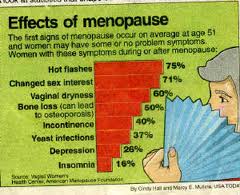In the February 19, 2003, issue of The Journal of the American Medical Association there was an extensive review of the topic of menopause and the time before and after menopause, called “perimenopause”.
The authors, Dr. Lori A. Bastian, from Duke University, and colleagues critically reviewed 1,246 articles on this topic and identified 16 studies that were accepted as being reliable regarding the review of this topic.
They were interested in finding menopause symptoms, signs and blood tests that would be reliable in terms of assessing whether a woman would be approaching menopause or would be in menopause. The result was that no single test or symptom was reliable, but that a number of tests and symptoms in combination were very helpful.
They measured reliability by “likelihood ratios (LRs)”. What this means is that any value above 1.0 is significant, but the higher the number, the more reliable and important is this fact or sign. I summarized the findings in table form below.
|
||||
| Findings: |
Likelihood ratio (LR): | Comments (by Dr. Ray Schilling): | ||
| self assessment of going through the transition | 1.83 | this is based on the effects of the changing hormones on the woman and how she feels it is affecting her |
||
| symptoms of hot flashes | 3.10 | lack of estrogen from ovaries leads to a lability of the skin blood vessels with increased skin perfusion as well as stimulation of the sweat glands | ||
| night sweats | 1.90 |
sleep pattern is changed and there is a loss of the day / night rhythm of skin perfusion | ||
| vaginal dryness | 2.64 | due to lack of estrogen | ||
| high follicle-stimulating hormone levels |
3.06 | feedback from estrogen missing, which stimulates the hypothalamus of the brain to produce more FSH hormone |
||
| low inhibin levels | 2.05 | this is a newer test, which is more specific than the FSH test and also has some importance in fertility work-ups | ||
| Self-assessment of perimenopausal status | 0.25 | this is not a reliable test as it is below 1.0. It was included to show how good the other tests are in comparison | ||
The authors concluded that there is no need for blood tests for menopause diagnosis in a woman, if several points of the first 4 findings are positive (top part of the table).
Here is a link regarding menopause.
Last edited December 9, 2012






